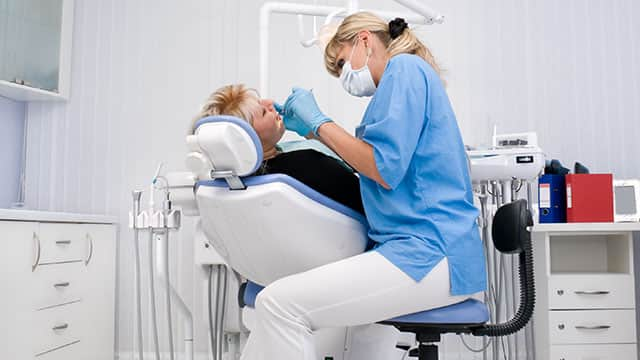Signs of Gingivitis
Gingivitis is caused by plaque build-up. It irritates the gum tissue. These are some of the signs that you may have gingivitis.
- Gums are red, swollen, and sensitive to touch.
- Your gums bleed easily.
- Your teeth appear longer.
- Chronic bad breath
- Gingivitis can cause a pocket to form between your tooth and gum.
- An infection can occur in the pocket between the tooth and gum.
If you think you have gingivitis, it’s essential to take care of it early. See your dental professional. Get a checkup and a deep cleaning. Take care of your teeth and gums at home. These things can help reverse gingivitis and prevent it from developing into a more severe form of periodontal disease.
Signs of Gum Cancer
Gum cancer is an oral cancer. According to the National Institute of Dental and Craniofacial Research, there are about 53,000 new cases of oral cancers every year. Patches or irregular growths on the gums can be signs of gum cancer. These patches and growths are red and white in color. Their scientific names are erythroleukoplakia (red and white patches or growths) and leukoplakia (just white) or erythroplakia (just red). Leukoplakia can be benign, but erythroleukoplakia and erythroplakia are more likely to be malignant.
Gum cancer can be confused with gum disease, which is why it’s important to keep up with your regular dental appointments. These types of cancers can spread quickly. Early detection is important for the best possible outcome. You should see your dentist if you have any unusual growths on your gums that don’t clear up after two weeks. Your dentist may recommend a biopsy.
Is There a Link Between the Two?
Oral cancer does not start with signs of gingivitis. There is no relationship between the two. However, a study shared by Cancer Epidemiology, Biomarkers & Prevention showed that older women with a history of gum disease might have a higher risk for developing other types of cancer, such as breast, lung, esophagus, and melanoma. The connection between gum disease and those cancers is not clear, but it does give you another reason to take great care of your oral health.
What You Can Do
Gingivitis and gum cancer are two different things. But you should take both of them seriously. Seeing your dental professional regularly for checkups and cleanings is one of the best things you can do to reduce your risk of developing gingivitis and gum disease and detect any form of oral cancer, including gum cancer early stage. Your dental professionals can see and diagnose any issues before they turn into significant issues. Having an excellent oral care routine at home is a must as well. This includes brushing at least twice a day (after each meal, if possible). Flossing (also known as interdental cleaning) at least once a day can minimize your chances of developing gingivitis. Not using tobacco products and drinking alcohol in moderation can lower your risk of developing an oral cancer.
If you see or feel something on your gum that wasn’t there before, or if your gums are tender or swollen, don’t panic. It’s probably nothing, but if it doesn’t go away, you should absolutely get it checked out. Contact your dental professional because early treatment is the best treatment.
This article is intended to promote understanding of and knowledge about general oral health topics. It is not intended to be a substitute for professional advice, diagnosis or treatment. Always seek the advice of your dentist or other qualified healthcare provider with any questions you may have regarding a medical condition or treatment.
ORAL HEALTH QUIZ
What's behind your smile?
Take our Oral Health assessment to get the most from your oral care routine
ORAL HEALTH QUIZ
What's behind your smile?
Take our Oral Health assessment to get the most from your oral care routine
Join Us
Get the best of your oral health routine and take it to the next level with expert advice, recommendations, products and solutions and special offers.
Join Us
Get the best of your oral health routine and take it to the next level with expert advice, recommendations, products and solutions and special offers.















